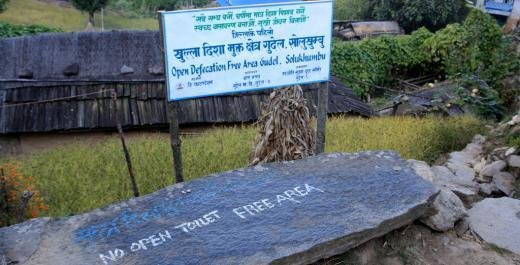KATHMANDU, Nepal (GPI)-- Villagers are collecting cement, pebbles, iron rods and pipes in Panchthar, a district in eastern Nepal. They are building toilets for their homes. Menuka Sharma, 40, constructed her family’s first toilet in March 2013.
“We did not have any toilet, nor felt the necessity of it for generations,” Sharma says. Sharma built a toilet under pressure from the Memeng village development committee, a local administrative body. It cost her 30,000 Nepalese rupees ($315). “On insistence of the VDC,” Sharma says, “I was forced to construct one, which cost me quite some money – enough to feed my family for a year.” But Sharma and her family members did not use the new toilet at first because they did not know how, she says. Instead, they continued to defecate in fields, corners, creeks and forests. “Initially, we thought it unnecessary to build a house for a toilet,” she says. “However, we are now happy to use it.” Access to an enclosed toilet has increased Sharma’s sense of dignity, she says. “If any male family member, neighbor or relative would see me defecating in an open place, I would be terribly ashamed and avoid them for many days,” Sharma says. “These days, however, I go to the closed toilet without any hesitation whatsoever.” The government and nongovernmental organizations are working together to ensure that every home has a toilet and rural areas are free of open defecation. Citizens with new toilets say their construction has made life easier. But poverty, illiteracy and socio-cultural traditions leave some citizens resistant, so the government is imposing social sanctions to persuade them to build toilets in their homes. To make the initiative sustainable, government representatives and health workers call for more education about the importance of sanitation in hopes of eliminating diseases – and the staggering medical costs – that open defecation causes. Across Southeast Asia, more than 600 million people lack access to toilets, according to UNICEF. Contaminated water can cause infectious diarrhea, which can lead to illnesses, such as cholera, that take thousands of lives each year. The government has measured progress, though. In 1990, just 6 percent of households here had toilets, according to the government’s 2011 Sanitation and Hygiene Master Plan. The number rose to 62 percent, as of the 2011 census. There are many reasons why toilets are not common here. Poverty, a lack of awareness and a dense population top the list. The government’s master plan also suggests that socio-cultural factors – including the taboo of a father and daughter-in-law sharing the same toilet – have long prevented families from installing toilets in their homes. Sandhya Basnet, an associate professor of sociology at Tribhuvan University in Kathmandu, Nepal’s capital, says that governmental and nongovernmental organizations are working together to raise awareness around the benefits of toilet use. The government’s master plan prioritizes education as the primary way to advance sanitation and environmental goals by 2017, says Padam Bahadur Kunwar, an engineer at the Department of Water Supply and Sewerage in the Ministry of Urban Development. To make this goal a reality, every home in Nepal must have a toilet, and open defecation must stop in rural areas. “We are working on the first phase of this program to have such toilets all across the country,” Kunwar says. Local government bodies are implementing the program on the ground. “We have started working since 2012 to have all the 41 VDCs of Panchthar free of open defecation,” says Anil Prasad Kesari, the chief of the Panchthar District Drinking Water and Sanitation Office. “We aim to finish construction of toilets and to meet the target of declaring open-defecation-free area in September 2013. The work is going on at a fast pace.” Although the government does not provide direct financial assistance to families building toilets, it does offer qualifying low-income families materials and technical advice, Kesari says. “[The] government does not give cash,” Kesari says, “but assists the poor families – as certified by the local VDC – by way of a sack of cement of 50 kilograms (110 pounds), pans, pipes, steel rods and technical know-how. The concerned family has to provide the necessary labor.” In order for the government to deem an area free of open defecation, it must not have any open access to human waste. Every household must also have an area with a covered, well-maintained toilet and soap for washing hands. Every village development committee throughout the country must maintain sanitation and hygiene standards even after the government declares an area to be free of open defecation. Government officials visit residents’ homes to check that they use their toilets regularly, to ensure they have adequate supplies of soap to wash their hands, and to educate them about the safe disposal of household waste, Kesari says. Citizens say the construction of toilets has improved their lives. Bimala Sambahamphe, 25, also from Panchthar, says that pedestrian traffic by her family’s home made it hard for her family to defecate in the open. Hundreds of people use the trail in front of their home as a thoroughfare to the district headquarters. “When finally we squatted for defecation, somebody else would show up,” she says. “We had to hurry up and stand still.” Sambahamphe says menstruation added additional challenges. “It was extremely difficult to change the absorbent cloth pieces during menstruation,” she says. Several months ago, her family constructed a toilet in their home. “I am now free from all these hassles because there is a toilet at my house,” she says.















